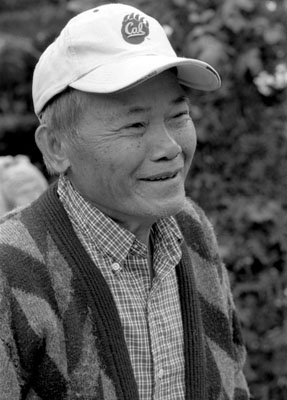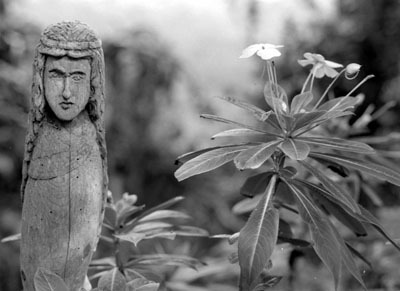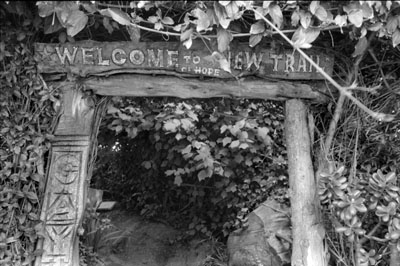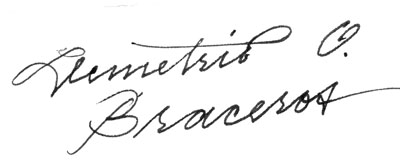A Commons Of Wonder
A Commons Of Beauty
under it was written, "Let there be Light."
"There was darkness here," "Evil.
It needed light."
"These are not mine,"
"Whatever this creative ability it is that has been given to me, it is not mine to claim for myself, but to use for the good of all."
All the wood for the carvings comes from the park itself
I met a woman taking a stroll just for the pleasure of being there. She lived nearby, she told me. She loved the park. Everyone does, she said.
having an entirely relaxed conversation with a young woman I’d never met before was a reflection of the gardener’s work and its atmosphere suffusing the little park.
a commons
the importance of having commons in a community and whose efforts are responsible for a lovely community
"we’re always trying to help the artists to realize their work. It fulfills another function."
notice that some
include text, like the carved overhead gate "Welcome to the New Trail of Hope."
a carving of a woman, her hands gripping a ship’s wheel with the following words painted on it, "Energy is the Capacity of Doing Work. Work is the Tendency of Moving Body. Keep on Moving for Good Health."
"I don’t care if people take them,"
"I can always make more."
"Whoever takes a piece might need that piece."
+++
This is from the article below. The article is from Work & Conversations
"All I have produced before the age of seventy is not worth taking into account. At seventy-three I have learned a little about the real structure of nature, of animals, plants, trees, birds, fishes and insects. In consequence when I am eighty, I shall have made still more progress. At ninety I shall penetrate the mystery of things; at one hundred I shall certainly have reached a marvelous stage; and when I am a hundred and ten, everything I do, be it a dot or a line, will be alive." -- Hokusai
Demetrio Braceros
New Trail of Hope
http://www.conversations.org/story.php?sid=106sA few casual remarks first brought the little city park to my attention. I’d meant to check it out, but now several weeks had passed and I still hadn’t made the trip over to San Francisco. There’d been something about a little Asian man. This amazing place. Was it on Cayuga Street?
 The park is on Cayuga Street, right at the end, a few blocks from Geneva and up against the concrete wall of Highway 280. BART trains run overhead along the north side of the park, each train contributing an earsplitting metallic whine of steel on steel to this enchanted little place. It is small, two, maybe three acres including the senior center and tennis courts attached. The day I found it, after poring over a city map with a magnifying glass, the sky was overcast. My first glimpse into the park revealed a crowd of wooden sculptures integrated into the landscaping. Making my way into the park, I was shocked to see so many pieces of art. It was a city park, after all. At least I thought so. But looking around, I found this hard to believe. Sure, one sees a piece or two of public art here and there, but nothing like this. And official public art always reveals its provenance by a sure sign: its life has been removed via bureaucratectomy. But the life in this work was palpable. Unmistakably, it was outsider art. It appeared to have arrived entirely intact and unprocessed by anything other than a singular poetic sensibility. It was shocking. And what was an entire symphony of outsider art doing in a city park? This was puzzling. I looked around for someone who might fit the vague description I’d heard several weeks earlier of "a little Asian man," but no such figure was to be found.
The park is on Cayuga Street, right at the end, a few blocks from Geneva and up against the concrete wall of Highway 280. BART trains run overhead along the north side of the park, each train contributing an earsplitting metallic whine of steel on steel to this enchanted little place. It is small, two, maybe three acres including the senior center and tennis courts attached. The day I found it, after poring over a city map with a magnifying glass, the sky was overcast. My first glimpse into the park revealed a crowd of wooden sculptures integrated into the landscaping. Making my way into the park, I was shocked to see so many pieces of art. It was a city park, after all. At least I thought so. But looking around, I found this hard to believe. Sure, one sees a piece or two of public art here and there, but nothing like this. And official public art always reveals its provenance by a sure sign: its life has been removed via bureaucratectomy. But the life in this work was palpable. Unmistakably, it was outsider art. It appeared to have arrived entirely intact and unprocessed by anything other than a singular poetic sensibility. It was shocking. And what was an entire symphony of outsider art doing in a city park? This was puzzling. I looked around for someone who might fit the vague description I’d heard several weeks earlier of "a little Asian man," but no such figure was to be found.
However, since I’d brought my camera I decided to make a leisurely photo tour of the garden. Quickly, I laid out a mental grid, the better to wander freely, and was satisfied that no piece of art would escape my notice. (A later visit revealed pieces I’d missed.) I took my time happily studying one delight after another and just before I left, out of curiosity, I did a quick count: not including the gardener’s handmade fences and other constructions, there were about one hundred individual carvings placed throughout the grounds.
My second visit was almost an accident. I was with my wife. We were returning from a family outing near Half Moon Bay. On a whim, I’d decided to take 280 north instead of crossing the bay at the San Mateo Bridge. An obligation on my wife’s part hadn’t left us much time to spare. "The garden is right over there," I mentioned as we were sailing by on 280. "Let’s go see it," my wife said, to my surprise. So we pulled off the freeway. This time I looked again for the artist. Sweeping leaves over in the corner of a patio I spotted a short man, head down, pushing a broom—a janitor, one might guess. Without already having a clue, it would never have occurred to me to walk over and ask, as I did, gesturing with a sweep of my hand: "Are you the man responsible for making all this art?"
He glanced up at me and then looked down again. Suddenly I felt rude. "Yes," he admitted with a laugh tinged with something like apology. I introduced him to my wife. "Well, it’s really wonderful!" I said with, perhaps, a little too much ooomph. Our conversation was brief. Time was short. The moment, compressed, was itself a small drama of unspoken and unresolved, but touched upon, potentialities: strangers face to face. What is it that you’re doing here so much from your heart? What I remember is this, his reading the situation and summarizing: "I wanted to inspire the kids."
 I would return. I wanted to publish something. I wanted his photo. I wanted to find out if he would be okay with being published, and I wanted to learn more about the whole story. But I’d never met an artist who conveyed less interest in gaining attention for himself. I wondered if he’d allow me take his photo. I wondered what I’d do if he asked me not to publish anything. I’ll do it anyway, I thought. It was a public park, after all. At least I’d learned that much, even though I still didn’t know the gardener’s name.
I would return. I wanted to publish something. I wanted his photo. I wanted to find out if he would be okay with being published, and I wanted to learn more about the whole story. But I’d never met an artist who conveyed less interest in gaining attention for himself. I wondered if he’d allow me take his photo. I wondered what I’d do if he asked me not to publish anything. I’ll do it anyway, I thought. It was a public park, after all. At least I’d learned that much, even though I still didn’t know the gardener’s name.
About a week later, one evening I called a friend, "Carlo, there’s something I think you’d enjoy. Are you free tomorrow morning?" He was. I picked him up at 10 am and we headed across the bay to San Francisco. It was another overcast day; the soft light would be perfect for a few more photos. Arriving, I spotted the gardener right away; he was hand-watering a row of hydrangeas. Carlo and I walked up and introduced ourselves. I hastily explained myself. I don’t know if he remembered me, but it didn’t matter. He seemed happy to talk and I noticed he was looking considerably nattier, wearing an argyle sweater and button down shirt. When I asked if I could take his photograph, he took a moment to straighten his collar. It was going to work out.
I’d asked Carlo to come along with me on a sudden impulse, but thinking about it later, I realized he was the perfect choice. No one I knew could more genuinely have appreciated this unusual man. As the three of us talked, at a certain point, I realized the atmosphere had been undergoing a slow but continuous process of brightening—even as Carlo and I craned our ears trying to decipher Demetrio’s responses to our questions. We were probably getting less than half the words, but something else was going on, too. I had no doubt the gardener felt it, also.
Somewhere in the middle of all this, I finally remembered something: "What’s your name?" I asked, and I took out the pen and paper I’d brought for just this purpose. "Do you mind writing that down?" I asked. Very carefully, he wrote it out in a fine, ornate hand: Demetrio O. Braceros. Yes. That was it. Smiles all around.
Demetrio was born in the Philippines. He had taught industrial arts there. He’d come to the Bay Area in 1977, I think. He’d worked at the Arboretum in Golden Gate Park for three years. I didn’t get the details about how he was given responsibility for the undeveloped parcel of land on Cayuga Street, but it happened in 1986, twenty years ago. At that time the place was just a raw stand of weeds and unkempt trees. In the neighborhood, he told us, "there were prostitutes, drug dealers and crime. People got killed up there," Demetrio told us, pointing to houses along the southern edge of the park. It was bad.
"I thought to myself, how can I help this place?" he told us. Speaking to Carlo, he tried to explain himself by quoting a biblical reference, "Let there be Light." It was hard to make out the words. Demetrio took Carlo by the arm and we all walked over to another one of his sculptures, a bust which might have been the head of Jesus. It was hard to say, but under it was written, "Let there be Light." Demetrio pointed to it. "There was darkness here," he said. "Evil. It needed light."
 "These are not mine," he said, speaking of all the pieces of sculpture he’d made. Across the language barrier I made out something like this: "Whatever this creative ability it is that has been given to me, it is not mine to claim for myself, but to use for the good of all." All that he did, he told us, was for someone else: his employer, "the taxpayers," he said, pointing to us. It went beyond that, I knew. The explanation was another piece of shorthand. Braceros, as best I could understand, landscaped the entire site, choosing the plants and getting them planted, and he’s maintained it ever since. But that was only the beginning of his work, the part he was being paid to do. There was another part, the part he felt called to do for other reasons. All the wood for his carvings comes from the park itself, he told us. The first large piece came from a big Monterey Cypress that had blown over. "Here it is, over here," he said, leading us to an impressive carved figure that, somehow, I’d missed before. It was tucked into a half circle of large bushes. He explained that the piece showed a man reading "The Book of Knowledge." As he searched for words to explain his idea more fully, I remembered what he’d said when my wife and I had met him earlier: "I wanted to inspire the kids." This piece was about the importance of learning, of getting an education.
"These are not mine," he said, speaking of all the pieces of sculpture he’d made. Across the language barrier I made out something like this: "Whatever this creative ability it is that has been given to me, it is not mine to claim for myself, but to use for the good of all." All that he did, he told us, was for someone else: his employer, "the taxpayers," he said, pointing to us. It went beyond that, I knew. The explanation was another piece of shorthand. Braceros, as best I could understand, landscaped the entire site, choosing the plants and getting them planted, and he’s maintained it ever since. But that was only the beginning of his work, the part he was being paid to do. There was another part, the part he felt called to do for other reasons. All the wood for his carvings comes from the park itself, he told us. The first large piece came from a big Monterey Cypress that had blown over. "Here it is, over here," he said, leading us to an impressive carved figure that, somehow, I’d missed before. It was tucked into a half circle of large bushes. He explained that the piece showed a man reading "The Book of Knowledge." As he searched for words to explain his idea more fully, I remembered what he’d said when my wife and I had met him earlier: "I wanted to inspire the kids." This piece was about the importance of learning, of getting an education.
On that first day when I’d visited the park, halfway through my second roll of film, I met a woman taking a stroll just for the pleasure of being there. She lived nearby, she told me. She loved the park. Everyone does, she said. As I stood there talking with her, it struck me that having an entirely relaxed conversation with a young woman I’d never met before was a reflection of the gardener’s work and its atmosphere suffusing the little park. Its grounds, it occurred to me later, are a commons, and the thought brought up a number of poignant associations. I thought of Karl Linn who devoted a good part of his life to educating people about the importance of having commons in a community and whose efforts are responsible for a lovely community garden in Berkeley. I had met Linn and interviewed him in that garden a few years before he died. [The interview is on the Web site.] Linn was not a visual artist himself, but artists frequently came to him and wanted to participate. He told me he had learned something from them. "Now," he said, "we’re always trying to help the artists to realize their work. It fulfills another function." That’s how he put it. It fulfills another function.
Walking through Cayuga Park, one will notice that some of Braceros’ pieces include text, like the carved overhead gate "Welcome to the New Trail of Hope." I stopped before a carving of a woman, her hands gripping a ship’s wheel with the following words painted on it, "Energy is the Capacity of Doing Work. Work is the Tendency of Moving Body. Keep on Moving for Good Health."
 One piece that Carlo and I were both looking at was of a man seemingly holding his hands over his ears. "Is that about the noise of BART trains coming by?" I asked. Demetrio laughed. "Look here," he said pointing to the head. "Look closer." There was something at the back of the head. Carlo and I bent closer. "Is that a crab?" Carlo asked. Demetrio smiled. If I’d had more presence of mind, or if the language problem wasn’t so daunting, I would have asked if the crab was a metaphor symbolizing some problematic condition nagging at people in the backs of their minds. Who knows? I didn’t ask that question, but a couple of fragments of things Demetrio said led me away from a tendency I’m familiar with, of seeing work of such transparency and feeling as being quaint, sentimental. What do we really understand about this realm of feelings? But to dismiss this work as quaint, sentimental, "merely"outsider art, would certainly be an ontological mistake. I have no trouble accepting the proposition that the work of Demetrio Braceros is responsible for the actual transformation of a city neighborhood.
One piece that Carlo and I were both looking at was of a man seemingly holding his hands over his ears. "Is that about the noise of BART trains coming by?" I asked. Demetrio laughed. "Look here," he said pointing to the head. "Look closer." There was something at the back of the head. Carlo and I bent closer. "Is that a crab?" Carlo asked. Demetrio smiled. If I’d had more presence of mind, or if the language problem wasn’t so daunting, I would have asked if the crab was a metaphor symbolizing some problematic condition nagging at people in the backs of their minds. Who knows? I didn’t ask that question, but a couple of fragments of things Demetrio said led me away from a tendency I’m familiar with, of seeing work of such transparency and feeling as being quaint, sentimental. What do we really understand about this realm of feelings? But to dismiss this work as quaint, sentimental, "merely"outsider art, would certainly be an ontological mistake. I have no trouble accepting the proposition that the work of Demetrio Braceros is responsible for the actual transformation of a city neighborhood.
We spent maybe forty-five minutes with Demetrio. At certain points he laughed and reached out to grab Carlo or me by the arm, to make a point. Somewhere in the oddly rewarding ambiguity of our struggle to converse together, it seemed to pop out that Demetrio's pieces of art don’t get stolen. I wasn’t sure that was what was said, but it suddenly occurred to me that, of course, many of these pieces could easily be carried off. "So people don’t steal the sculptures?" I asked.
Demetrio pointed to a couple of sticks in the ground. They must have served to hold up a now missing carving. "That one was taken," he said. He was laughing. Carlo looked slightly disturbed, as I recall. Carlo had a question about that and pointed, I don’t know why, to the carving of the man with a crab on his head. "Do you want it?" Demetrio asked brightly. "No. No," Carlo said, laughing. "It belongs to the park!" If Carlo hadn’t refused the piece, I’m convinced that Demetrio would have picked it up right there and handed it to him.
"I don’t care if people take them," he said. "I can always make more." I’m pretty sure this is what he said, and further, I have the distinct impression that he also had this thought, which he wasn’t quite able to put into words: "Whoever takes a piece might need that piece." Listening to all this, I confess I had to struggle with a greedy streak that the gardener’s generosity ignited, but I managed to keep my mouth shut. "Can you take us around and talk about each piece?" Carlo asked Demetrio. Demetrio looked at me. He had work to do. He couldn’t spend all day with us. "No Carlo," I said. "We have to go now." Demetrio looked at Carlo with a mischievous grin, "Next time we can stand hip to hip [he made a little gesture] and talk about each one."
I did not call the San Francisco Department of Parks and Recreation to congratulate them on having, and keeping, in their ranks this exemplary figure, but it does astound me. That for twenty years, Demetrio Braceros has pulled down a paycheck for doing far more than anyone could imagine in carrying out the duties of his job is an example, either of an enlightened policy, or of some enlightened management inside the system, or both. Or maybe it’s just an extraordinary accident. But Braceros told us that he had received a special award from the Parks and Recreations Department. The fact that Cayuga Park stands as a veritable beacon of light is something for which I think we also owe the San Francisco Department of Parks and Recreation a debt of earnest gratitude. How can anyone who learns even the outline of this story not feel the opening to a new trail of hope?
--by Richard Whittaker; Apr 2, 2007
===Labels: Parks, Commons, Sculptures, Hope, Trails, Beauty
--
Subscribe to emails from:
- Better World News: http://at7l.us/mailman/listinfo/bwn_at7l.us
- Learning News - children learning, how mind works: http://at7l.us/mailman/listinfo/learn_at7l.us
- Good Morning World - Robert & Barbara Muller's daily idea-dream for a better world: http://www.goodmorningworld.org/emaillist/#subscribe
or send a request a subscription to any of the three lists here.
To view these blogs:
- Better World News
- Learning News
- Good Morning World - Robert and Barbara Muller's daily idea-dream for a better world

No comments:
Post a Comment